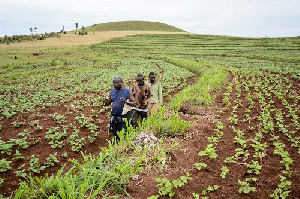Opinions of Friday, 2 November 2018
Columnist: Yaw A. O. Ansah
Narrowing the inequality gap by investing in Agriculture
The main crop cultivated by Inusah Tanko, 59, and his compatriots in the Zhiong Community in the Savelugu Municipality is maize, one of the most patronised staple crops in Ghana that contributes significantly to consumer diets.
Occasionally, he intercrops with groundnuts. His wife Amina Ibrahim, on the other hand, cultivates bra, okro, pepper and tomatoes to support the family.
The yields of Tanko and co continue to fluctuate between 1.5 and 1.8 metric tonnes per hector annually because they follow the same agronomic practices on the same piece of land handed to them by their fathers 30 years ago. A study conducted by experts at the Savannah Agriculture Research Institute says farmers can harvest over seven tonnes per hector if the right seed and fertilizer recommendations are adhered to.
Just like many homes in the Savannah Zone, Tanko’s family largely live on the yields, which run out in the cause of the year. Amina has to strive to provide three square meals a day for the family members, especially the children. At a point in the year, some parents could feed their children twice a day while other children get just a meal.
It is not too surprising that the 2017 Ghana Micronutrient Survey revealed that anaemia is 53. 2 per cent higher in the northern belt compared to that of middle and southern belts, which are 28.2 per cent and 32.3 per cent respectively.
Challenges in the agriculture sector
Mr Ignatius Tindjina, an Agriculture Expert, explains that the challenges resulting in low-crop yields include low soil fertility, soil erosion, inappropriate land use,
soil degradation and low use of certified seeds and improved crop varieties.
He indicates that, for instance, the current fertilizer recommendation was prescribed around 1972, 46 years ago, and has since been the recommended fertilizer used by farmers, who refer to it as “blanc or blanket fertilizer recommendation.”
Mr Tindjina said: “The continuous burning of the land has depleted the soil nutrients by killing microbial organisms that increase nutrients availability to plant by incorporating organic materials into the soil and unlocking the nutrients held within dead organisms and plant litter.”
“It has, therefore, made the soil deficient in some nutrients making it unable to boost plant growth as it needs to. That was the reason why the fertilizer stopgap measure was introduced by the Government through the extension services of the Ministry of Food Agriculture to farmers to adapt to improve yield.”
“Currently farmers are advised under the blanket fertilizer subsidy package to apply two bags of 50 kilogramme NPK and one bag of 50 kilogramme of Urea or Sulphate of Ammonia per acre in a maize farm. This directive has outlived its usefulness. This is because the continuous cropping has depleted the soil nutrient to an extent that currently, fertilizer recommendation cannot ensure sustainable crop production.”
While, applauding successive government’s efforts at promoting the use of fertilizer under various agriculture initiatives such as the current Planting for Food and Jobs, Mr Tindjina called for a review of the current fertilizer recommendation for farmers to adopt the soil testing and nutrient deficiency mapping.
This, he says, will scientifically show the soil deficiencies and make appropriate recommendations that are site-specific and ensure that plants get the right fertilizer in the right quantities.
Soil Testing
This involves the samplings, preparation and analysis of soil samples to determine the nutrient composition and other characteristics such as the acidity or pH levels. A soil test can determine fertility or the expected soil growth potential, which indicates nutrient deficiencies, potential toxicities from excessive fertility and inhabitation from the presence of non-essential trace elements.
This test is able to provide information about nutrient availability in soil, critical for nutrient management planning. For instance, in the three regions of the north, studies conducted by a USAID Agriculture Technology Transfer Project has indicated that there is the need to have the crop and site-specific fertilizer recommendations to address the current soil fertility challenges.
Mr Geoffrey Kwaku Honu, the Eastern Regional Director of Agriculture in charge of Projects, at a recent forum, remarked that soil testing had become imperative because it enables farmers to know which soil type is good for which crop in order to reduce the use of large quantities of fertilizers.
To increase productivity, farmers, especially Tanko and his compatriots, must apply plant nutrients that their soils lack to increase yield and to enable them to feed their families and even sell the surplus to get some revenue.
The Way forward
Farmers can only access soil testing services at a moderate cost if the government invests in agriculture research to test new and appropriate technologies, especially fertilizers, that can be taken up by small-scale farmers with limited education, especially by women farmers.
The recent Inequality Report by Oxfam, SEND-Ghana and the Ghana Anti-Corruption Coalition (GACC) said the wide gap between the poor and the rich can be reduced if government provide more funding in professional and technical methods to increase agricultural output to a level capable of feeding the population.
Mrs Beauty Emefa Narteh, the Executive Secretary of GACC, said agriculture could be a powerful contributor to inclusive and equitable growth, reducing poverty and rural-urban inequality.
However, she says this requires an increase in public investment in agriculture, and a focus on the smallholder sector to ensure they contribute to reducing poverty and inequality.
It is imperative to note that Ghana has promised the world that she would ensure her children do not go hungry under the Sustainable Development Goals geared towards ending poverty, protecting the planet and ensuring that all the people enjoyed peace and prosperity by 2030.
It is refreshing to note that President Nana Addo Dankwa Akufo-Addo has been re-appointed as Co-Chair of the Eminent Group of Sustainable Development Goals Advocates, as this appointment will go a long way to help make the agriculture sector work and ensure that it receives adequate funding to lift more people out of poverty











